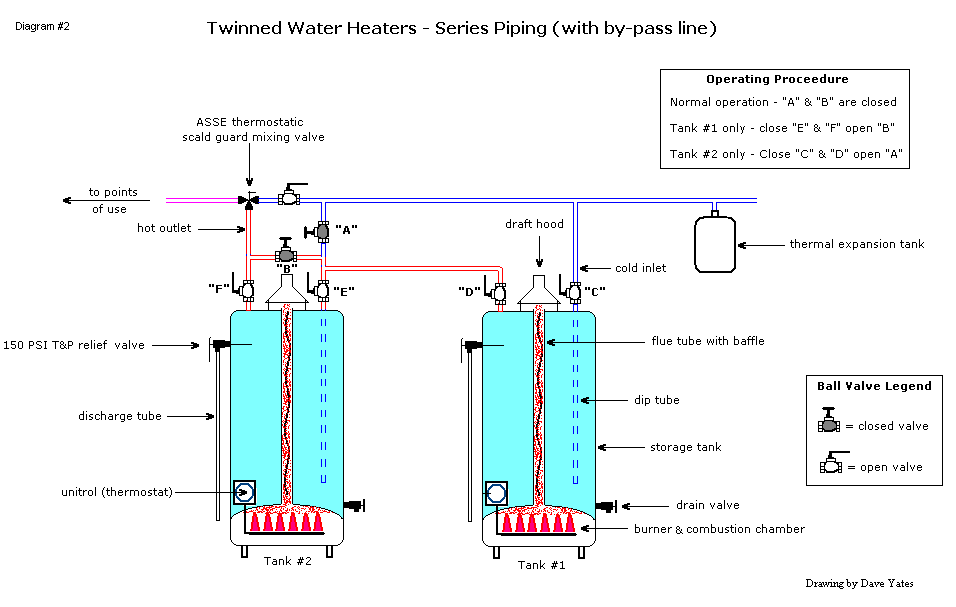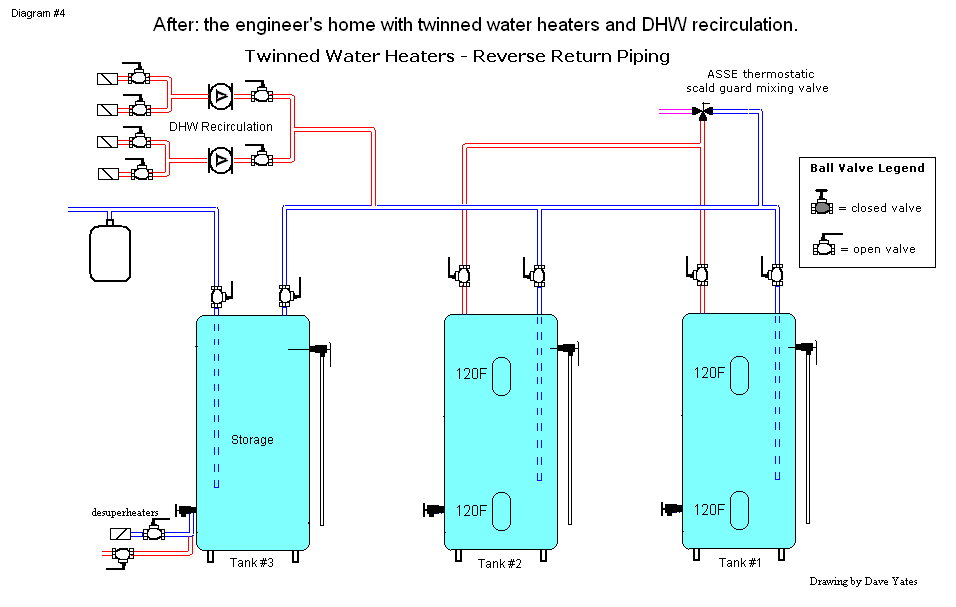Twinning water heaters
The best method for piping two water heaters.
Here’s a question to ponder: Which is the best method for piping two water heaters together — parallel or series? In a number of homes, we’ve had to correct improperly piped twinned water heaters and, in others, we’ve had to decide whether to install two working-as-one water heaters or install a much larger stand-alone model.
More often than not, the owners like the idea of two smaller water heaters to prevent future interruption of service when one fails or needs servicing.
Look at the unbalanced flow drawing in Figure 1 first. Think like water and follow the path of least resistance. More water will short-circuit through that first tank, reducing overall capacity and cause the first tank to work harder. The second tank will see a much lower flow and can, under the right circumstances, see virtually no flow.

ENLARGE
FIGURE 1
We once had a call for sediment in a home where the twinned water heaters were piped in this manner. The cause turned out to be black specks from the sacrificial anode rod in the primary tank, which were evident following the use of the family’s large whirlpool tub. When we changed to aluminum-based anode rods, the foul stench in the stagnant tank was quite repugnant, and that tank’s water was quite cloudy from stagnation and, quite possibly, bacterial amplification.
We could have easily piped those twinned tanks in series, but this home had large flow demands, which weren’t being met as the homeowners told us when we asked the right questions. Their Kohler bathing module had multiple body sprays (not unlike a car wash!) and more pressure was desired. They had even contemplated an auxiliary booster pump.
Although series piping can shave costs and work quite well under many circumstances, the first tank once again sees the lion’s share of the workload and will no doubt fail long before the second tank. If a bypass piping arrangement is not in place when that happens, interruption of service is assured until the first tank is replaced. See the series piping drawing in Figure 2.

ENLARGE
FIGURE 2
The best method for piping twinned water heaters of equal size is the reverse return method as shown in Figure 3. With valving installed as shown, no interruption of service is necessary unless both tanks fail simultaneously — a highly unlikely event. Note the incoming cold-water storage tank that now accepts heat energy from the geothermal desuperheaters.

ENLARGE
FIGURE 3
Thinking like water once again, we can easily see why reverse return piping balances the flow. On one side, the supply water wants to take the shortest route and dive into that first tank. On the outlet, by giving the second tank the shortest exit route, the flow literally can’t help but become balanced.
Bear in mind that this can only work if both tanks are the same volume. If mismatched tanks are twinned using the reverse return method, the smaller of the two will become exhausted more quickly, which will dramatically reduce the mixed water temperature in the outgoing flow. When twinning varying sizes, series piping works best if flow demands can be met.
I’ve also been asked if it’s prudent to disable one of the tanks to reduce energy consumption and to turn it back on when guests or seldom-needed large demands are placed on the hot water system. In a word — no. Stagnant water in potable water heaters invites a host of problems, not the least of which is bacterial issues.
Another potentially dangerous condition that can be brought on is thermal expansion and contraction. You’ll notice that these drawings include thermal expansion tanks and a suitably sized thermal expansion tank (remember Boyle’s Law) must be included in any area of a potable water heating system that can be isolated.
Although it’s true that the T&P valve will relieve pressure above 150 psi (using a higher pressure relief valve will void the warranty) and that the tanks are constructed to withstand twice that pressure, a vacuum will quickly damage the tank.
To witness this phenomenon, purchase a new and unused 1-gal. metal can; remove the cap and add a half cup of water; place it on a burner until steam vapor rises from the opening; remove it from the heat, quickly screw the cap back on and watch what happens. The same thing can happen to a valve-isolated tank as the water cools.
Long ago, I asked Mike Gordon of Bradford White Corp. to respond. He answered:
“Parallel and series installation of water heaters both have advantages and disadvantages. So the answer would be ‘it depends.”
“Parallel equalizes the run time of the heaters, distributes any mineral accumulation evenly and has lower water-side pressure drop. Series installation requires less piping and may be less expensive to install. In the BWC commercial installation manuals, we recommend parallel reverse return.
“From both an efficiency and performance standpoint, single and ‘twinned’ systems offer equal performance. The outside surface area of the two will be greater than a single unit. This results in higher losses from the twinned units. Recovery efficiency is about the same for both. Given the higher installation cost of the twinned unit, I would go with the single unit for most applications.
“However, in critical installations such as businesses (hotels, restaurants, car washes, etc.) that must have hot water to stay open, the twinned unit offers redundant capability.”
Figures courtesy of Dave Yates.
This article was originally published in PM Engineer in September 2000.